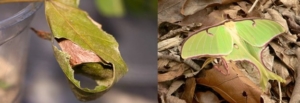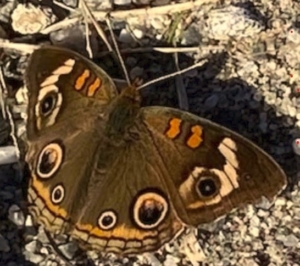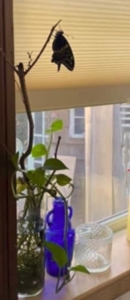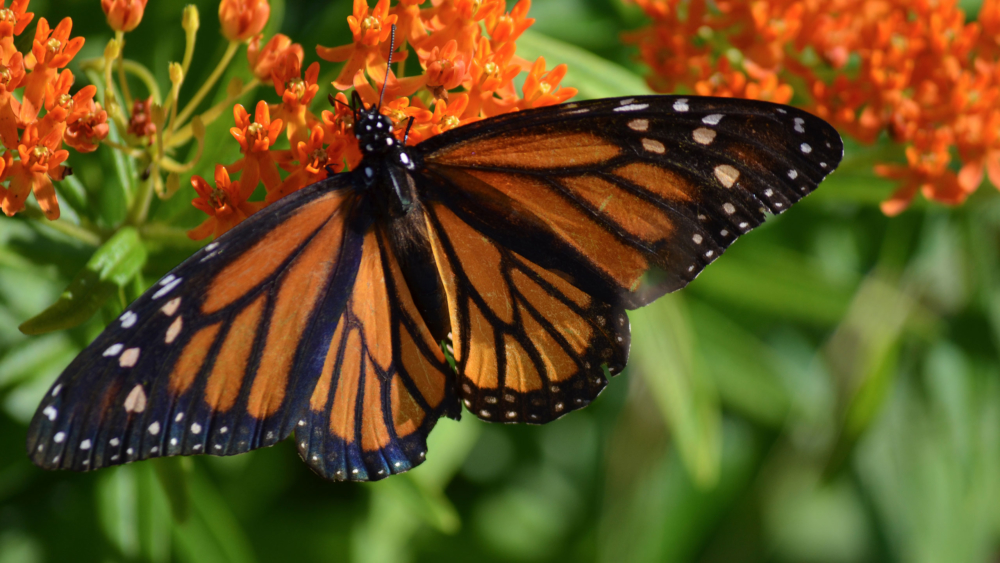On Overwintering Pollinators
By Marca Leigh
A couple years ago I had noticed that the Eastern Black Swallowtail caterpillars covering my fennel were disappearing one by one, most likely as bird food. While this is the sign of a healthy, normal ecosystem, my yard is an island amongst a sea of lawns, and heaven for lunching birds. I knew if I didn’t bring a few of them indoors, they’d all be gone in a few days. So I decided to raise Eastern Black Swallowtails that summer.
It was fascinating watching them eat the fennel l had grown and brought in for them, watching them pupate and eventually eclose from their chrysalis after a few weeks. Once their wings had dried I brought them outdoors and set them free into my pollinator garden which is free from pesticides and other chemicals.
This all went smoothly until about September, when I noticed one chrysalis hadn’t opened. It looked like a tiny petrified owl cemented to the small twig I had provided in the enclosure. My friends were sure it was dead, and I too wasn’t sure why it hadn’t emerged. I googled and found that some species do something called “overwintering”, they wait until the following spring to come out and be their “butterfly self”.
Others were skeptical, but I decided to keep the twig: I placed it in a vase in a north facing window in my dining room where it wouldn’t be disturbed by anyone or anything. The winter holidays came and went. I would glance over occasionally to check on it without too much thought. The month of May eventually rolled back around and I found myself once again taking in a couple of the swallowtail caterpillars indoors. I came down to check on those chrysalises early one morning and to my amazement, there she was, Aurora ( I named her after Sleeping Beauty) gently dangling from the twig in the vase, drying her wings. I had a slight moment of panic as I wondered how I’d get her outside without flying all around the house, but luckily she calmly crawled onto my warm hand and I just casually walked her out of the house into my garden. She sat a while on some flowers before finally taking flight, as if to say “thanks for the stay, it’s been nice”. Her iridescent black and azure wings shining in the sunlight, up and up she went into my patch of sky.
This was what all the native plant and pollinator garden sites and groups have been talking about, the fact that the world outside our homes does not die, and not all take off for warmer places. Much of our local wildlife is asleep in the brown brush and under layers of snow, transforming into their spring clothes.
In late September when the colorful foliage starts to fall on the grass and on the walks, some leaves may hold a passenger or two, clinging to an oak in a tiny patch of webbing, or curled up in a corner of a maple like a tiny astronaut in cryosleep. As the autumnal spaceships turn brown and drift with the wind in late October, human minds have traditionally practiced “tidying up” the outside world according to our own aesthetic…Fastidiously chopping leaves to bits with the blades of a mower, or blasting them into bags with noisy fume-emitting power blowers, only for them to be taken away to be shredded elsewhere.
Might we consider a kinder approach, one that would protect most sleeping cocoons by gently moving them with an electric powered blower that would mimic only the power of a windy day, into piles around trees and onto garden beds as a mulch blanket.
The piles can look intentional; so as to satisfy our neatness gene, and as the leaves slowly break down into soil in the rain and snow, the nutrients feed the roots of trees, bushes and garden beds.
The other option, of course, is to just let the leaves lie where they have fallen, if it’s possible where you live.
Leaves are a part of the cycle of nature. The same goes for dried hollow stems- they become insulated tubular homes for native bees and pollinating wasps. If one piece of the puzzle is taken away, the whole system – the ECO system- falls apart. Insect populations decline: impacted by leaf shredding or removal, pesticides and general habitat loss. Birds and small mammals, losing the large part of their diet, follow suit. Predators such as hawks, owls and fox also suffer.
If we could just change our minds a LITTLE about what is beautiful, by simply knowing more of the story, we can start healing the damage already done to our planet by starting in our own yard.
The joy of discovering caterpillars I’ve never seen before, like the Sycamore Tussock, of watching tiny fairies like plume moths flutter by, of the sea of lightning bugs putting on their sparkling midsummer display, and a landscape of colorful birds enjoying the bounty, and knowing that they all need the leaves and stems as part of their survival, makes it a no brainer. They are the nutrients, they are protection, they are home. If you love the beautiful, fragile web of nature in your space.. “leave the leaves and stems.”
Luna moth cocoon in leaf casing. (They love especially black walnut trees in the northeast )


A Common Buckeye at Short Beach, November 26th. They are staying longer as climate change warms our area

My Aurora…”my Sleeping Beauty” overwintering Eastern Black Swallowtail. I do not recommend taking these chrysalises indoors over the winter as they may come out early, mistakenly thinking it’s spring! I got lucky! instead, give them some protection outside if you can, and leave the dry sticks and stems until after they begin emerging.
Suggested Reading/Viewing For Becoming Your Best Planet Self:
“Leave the leaves ”
https://xerces.org/blog/leave-leaves-to-benefit-wildlife
https://www.purduelandscapereport.org/article/hidden-in-the-leaf-pile-luna-moths-woolly-bears-and-swallowtails-all-need-a-safe-place-to-hibernate/
Watch a caterpillar make a leaf into a sleeping bag
https://xerces.org/blog/5-ways-to-increase-nesting-habitat-for-bee
Create firefly habitat
Don’t put all your fallen leaves out for curbside pickup; build a firefly habitat instead!
“Leave the stems”
https://xerces.org/blog/5-ways-to-increase-nesting-habitat-for-bee


This is a beautiful piece of nature writing! And so informative.